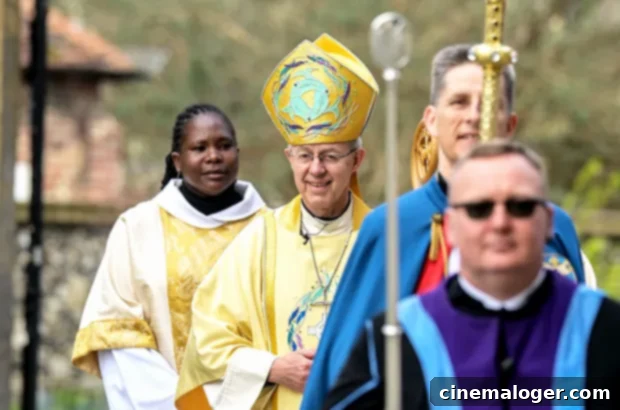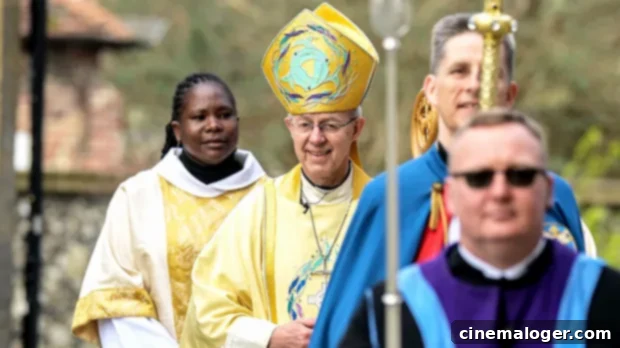The Archbishop of Canterbury: Justin Welby’s Pivotal Role in King Charles III’s Historic Coronation
- For over a millennium, the Archbishop of Canterbury has officiated the coronations of most English and British Monarchs.
- The current holder of this esteemed office is Justin Welby, the 105th Archbishop.
- A deeply significant moment during the ceremony involves the Archbishop privately anointing King Charles with Holy Oil.
As millions across the globe tuned in to witness the grand Coronation of King Charles III, one figure stood at the heart of the sacred proceedings: the Archbishop of Canterbury. This ancient and profoundly significant position within the Anglican Church, currently held by Justin Welby, is not merely ceremonial but central to the spiritual and constitutional legitimacy of the monarch. While many are intimately familiar with the intricacies of the Royal Family, it is the Archbishop who, by long-standing tradition, performs the anointing, blessing, and crowning of the new sovereign, embodying a continuous thread of history that stretches back over a thousand years. His presence underscores the deep-rooted connection between the British Crown and the Church of England, a relationship that defines the very essence of the British monarchy.
Indeed, the religious leader’s role is so integral that he features prominently throughout the televised ceremony, arguably as much as the principal members of the Royal Family. His every action, from the administration of the Coronation Oath to the presentation of the regalia, is laden with historical and spiritual meaning. This article delves into the profound history and contemporary significance of the Archbishop of Canterbury’s office, focusing on Justin Welby’s journey to this esteemed role and his crucial contributions to King Charles III’s Coronation.

Justin Welby: The 105th Archbishop of Canterbury and His Path to Leadership
The venerable office of the Archbishop of Canterbury has been held by over 100 individuals throughout the centuries, each leaving their mark on both the Church and the nation. The present incumbent, Justin Welby, is the 105th in this illustrious line. Born in London in 1956, Welby’s early career was markedly different from that of many religious leaders. He studied history and law at Trinity College, Cambridge, and spent 11 years in the oil industry, initially with Elf Aquitaine and later as Treasurer of Enterprise Oil. This background in finance and business management has often been noted as providing him with a unique perspective on leadership and the challenges facing modern society.
His call to ministry came later in life. Welby was first ordained as a priest in 1993, at the age of 37, embarking on a new spiritual journey. Over the next two decades, he served in various capacities within different churches and cathedrals, steadily climbing the ecclesiastical ladder. His dedication and theological insight were recognized when he was appointed as the Bishop of Durham in 2011, a significant and historic diocese. Just a year later, in 2012, the announcement came that he would succeed Rowan Williams as the Archbishop of Canterbury. Reflecting on this momentous appointment in an interview with The Times, Welby humorously admitted that his initial reaction was disbelief, thinking it was a “joke.” Since his enthronement in 2013, he has served with distinction, guiding the Church of England and the broader Anglican Communion through various challenges and opportunities.
A Millennium of Tradition: The Archbishop of Canterbury as the Highest Position in the Church of England
The title of the Archbishop of Canterbury is not just a prestigious ecclesiastical office; it represents the oldest continuous See in England, with its origins tracing back to the arrival of St. Augustine in 597 AD. Sent by Pope Gregory the Great, St. Augustine established the Christian faith in England and became the first Archbishop of Canterbury, laying the foundational stones for what would become the Church of England. This historical lineage imbues the office with immense spiritual and traditional authority. While the Archbishop primarily oversees the ecclesiastical province of Canterbury, his influence extends far beyond this geographical region. He serves as the spiritual leader of the Church of England and the symbolic head of the worldwide Anglican Communion, which encompasses millions of adherents across more than 165 countries.
Beyond his spiritual duties, the Archbishop actively participates in numerous church boards and synods that govern the Anglican Church, shaping its doctrine, policies, and pastoral care. His role also encompasses significant national responsibilities, including a prominent presence in key state ceremonies, most notably royal coronations. The tradition of the Archbishop of Canterbury crowning the sovereign is deeply embedded in English history and constitutional practice. As the official website of The Church of England states, “The first detailed coronation service is thought to have been drawn up by St. Dunstan, Archbishop of Canterbury, for the grand coronation of Edgar, first King of All England, at Bath Abbey in 973.” This historical precedent highlights the enduring nature of the office’s involvement in shaping the monarchy. While there have been rare instances where another cleric performed the coronation due to the Archbishop’s incapacitation or a vacant See, such occurrences are anomalies, underscoring the indispensable role of the Archbishop in modern times.

The Sacred Anointing: A Private Yet Profound Moment in the Coronation
Central to the Coronation of King Charles III, and indeed to all British Coronations, is the sacred act of anointing, a ritual entrusted exclusively to the Archbishop of Canterbury. As one of the preeminent leaders of the Anglican Church, Justin Welby was the chief officiant, guiding the ceremony with solemn dignity and deep spiritual reverence, as reported by Tatler. While the public ceremony culminated in the dramatic crowning of the monarch with St Edward’s Crown, it was the private anointing with Holy Oil that many consider the most sacred and spiritual part of the entire service.
During this intensely personal moment, King Charles was seated in the Coronation Chair, screened from public view by an intricately embroidered anointing screen. The Archbishop then applied consecrated oil, traditionally made from olives harvested from the Mount of Olives and consecrated in Jerusalem, to the King’s hands, breast, and head. This act symbolizes the monarch’s spiritual consecration and their divine right to rule, marking them as chosen by God. Despite King Charles’s Coronation being only the second to ever be televised in its entirety (following that of his mother), the anointing portion remained off-camera. This tradition of privacy for the anointing harks back to ancient customs and was similarly observed during Queen Elizabeth II’s Coronation in 1953. The decision to keep this moment private reinforces its spiritual gravity, emphasizing that it is a sacred covenant between the monarch and God, rather than a spectacle for public consumption.
Reflecting on Royal Service: Archbishop Welby’s Insights on Working with King Charles III
In the weeks leading up to the Coronation, Archbishop Justin Welby offered valuable insights into his working relationship with King Charles III, shedding light on the collaborative process of planning such a momentous event. In an interview with Sky News, Welby spoke warmly of the King’s active participation and deep thoughtfulness regarding the ceremony. “The King is someone who is very easy to work with,” he remarked, highlighting the monarch’s engaging approach to the intricate details of the service. He further elaborated, “He thinks very deeply about these things. His Christian faith comes through the whole time, and it’s been really fun.” This personal testimonial from the Archbishop painted a picture of a monarch profoundly committed to the spiritual dimensions of his role and actively involved in ensuring the Coronation reflected both tradition and his personal faith.
Beyond the planning process, Welby also revealed a profound symbolic gesture that underscored the historical weight of the See of Canterbury. As an homage to the earliest days of Christianity in England, the ancient Gospels of St. Augustine were incorporated into the Coronation ceremony. The Archbishop shared this detail on Twitter, emphasizing the profound historical and spiritual connection. He wrote, “The St Augustine Gospels will be used at the Coronation of His Majesty King Charles III tomorrow. A beautiful treasure of our nation’s Christian history, it was sent to the first Archbishop of Canterbury from Rome in the 6th Century AD.” He concluded his tweet with a prayer: “I pray the St Augustine Gospels would be both a reminder of God’s faithfulness throughout history, and a promise of His guidance throughout The King’s reign.” This thoughtful inclusion not only added a layer of historical depth but also served as a tangible link to the foundational moments of the Church in England, directly connecting King Charles III’s reign to over 1400 years of Christian heritage.
Engaging the Public: Archbishop Welby’s Prayers and Preparations for the Coronation
In the bustling lead-up to the Coronation, Archbishop Justin Welby utilized various platforms, including social media, to engage with the public and share insights into the significance of the upcoming ceremony. His Twitter account became a key channel for updates, theological reflections, and calls for prayer, reinforcing the spiritual dimension of the national event. One consistent theme in his posts was the encouragement of prayer for the Royal Family, particularly for King Charles and Queen Camilla as they prepared for their historic day. These public prayers allowed people from all walks of life to feel connected to the momentous occasion and to offer their spiritual support to the incoming monarchs. For instance, on the eve of the Coronation, Friday, May 5, he posted:
We pray for His Majesty the King, the Queen Consort and the Royal Family as they prepare for tomorrow’s #Coronation. pic.twitter.com/LOgTxr4XsT
— Archbishop of Canterbury (@JustinWelby) May 5, 2023
This direct and personal engagement through social media allowed the Archbishop to reach a broad audience, fostering a sense of collective anticipation and spiritual reflection ahead of the ceremony. His words served as a reminder that beyond the pomp and pageantry, the Coronation was fundamentally a service of dedication and prayer, both for the monarch and for the nation he serves.
The Grand Spectacle: A Coronation Rooted in History, Facing the Future
The Coronation Service of Their Majesties King Charles III and Queen Camilla was a truly global event, attended by an esteemed congregation of more than 2,200 guests within the hallowed halls of Westminster Abbey. This distinguished gathering included Members of the Royal Family, dignitaries and international representatives from over 200 countries, and approximately 100 Heads of State, all eager to witness this historic occasion. The beautifully hand-painted invitations, which featured intricate designs and were shared via the Royal’s official Instagram, were a testament to the meticulous planning and grandeur of the event.
While the guest list was extensive, a few notable absences garnered public attention. US President Joe Biden, though extending his well wishes, did not attend in person, with his wife, First Lady Dr. Jill Biden, representing the United States. Similarly, the Duchess of Sussex, Meghan Markle, remained in America with Prince Archie and Princess Lilibet. Despite these absences, the spirit of unity and celebration pervaded the ceremony.
In the official announcement for the King’s coronation, made back in October 2022, Buckingham Palace promised that the coronation would “reflect the monarch’s role today and look towards the future, while being rooted in longstanding traditions and pageantry.” This promise was fully realized during the magnificent ceremony on Saturday, May 6, at Westminster Abbey. It was here that Archbishop Justin Welby fulfilled his most ancient duty, performing the official crowning of King Charles III with the historic St Edward’s Crown and the subsequent crowning of Queen Camilla with Queen Mary’s Crown. His central role throughout the Coronation underscored not only the enduring power of tradition but also the continuous spiritual guidance offered by the Church of England to the British monarchy, bridging centuries of history with the promise of a new reign.
